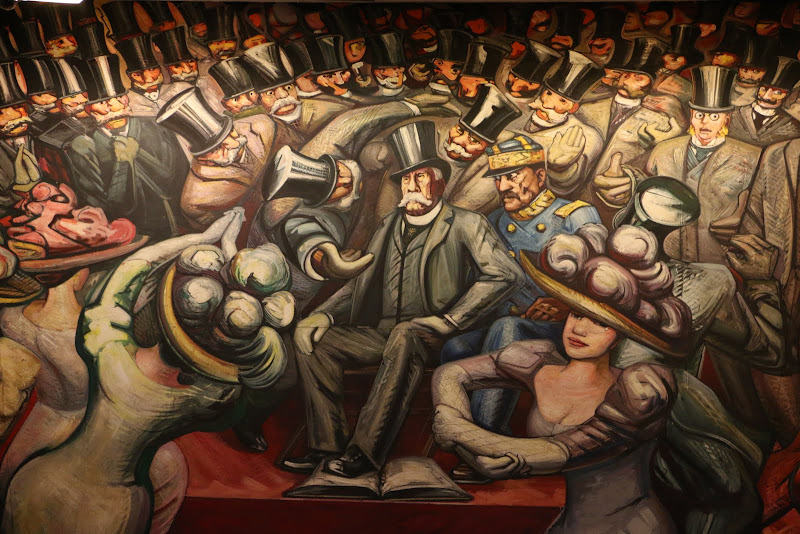 |
| Porfirio Díaz surrounded by his bourgeois francophile scientísts, technocrats and their women. Díaz steps on the liberal 1857 Constitution. Mural by David Siqueiros National Musuem of History, Chapultepec Castle |
As a teenager, Francisco was sent by his father to study business in France at the École des Hautes Études Commerciales, the School of Higher Commercial Studies. Madero's father was interested in Spiritualism, which was popular among the upper classes of Europe and the United States in the latter part of the 19th century, and the son adopted this interest. While in Europe, he involved himself with Spiritualism and came to believe he was a Medium. He also became interested in liberal democratic thought. After Europe, Madero's father sent him first to the Culver Military Academy in Indiana, then to the University of California at Berkeley to study modern agriculture.
A Son of the Porfirato Rises Up
A Son of the Porfirato Rises Up
In 1893, at the age of 20, Madero returned to Mexico to manage the family hacienda. When Díaz's appointed governor of neighboring Nuevo León, Bernardo Reyes, crushed a protest against Díaz in 1903, Madero felt called by the spirit of his brother, Raúl, who had died in childhood, to become politically active against the repressiveness of the Díaz dictatorship. He ran for local office and organized political clubs and newspapers.
When (in his interview with Creelman) Díaz raised the possibility that he would retire, Madero responded by writing a book, La sucesión presidencial en 1910 (The Presidential Succession of 1910) in which he proclaimed that the concentration of absolute power in the hands of one man – Porfirio Díaz – for so long had made Mexico sick. He also pointed out the irony that in 1871, Porfirio Díaz's political slogan had been "No Re-election".
Acknowledging that Porfirio Díaz had brought peace and a measure of economic growth to Mexico, Madero nonetheless argued that this was counterbalanced by the dramatic loss of freedom, including the brutal treatment of the Yaqui indigenous people in Sonora; the repression of workers in the Cananea mine, also in Sonora; excessive commercial concessions to the United States, and an unhealthy centralization of politics around the person of the President. Madero called for a return of the Liberal 1857 Constitution of Mexico. To achieve this, Madero proposed organizing a Democratic Party under the slogan Sufragio effectivo, no reelección ("Valid Voting, No Re-election"). Porfirio Díaz could either run in a free election or retire.
The book quickly became a bestseller in Mexico. Madero, to his own surprise, became a hero, the "Apostle of Democracy". Using his own wealth, he traveled around Mexico organizing an anti-Díaz re-election movement. Everywhere Madero spoke, he drew large crowds.
The Revolution BeginsThe book quickly became a bestseller in Mexico. Madero, to his own surprise, became a hero, the "Apostle of Democracy". Using his own wealth, he traveled around Mexico organizing an anti-Díaz re-election movement. Everywhere Madero spoke, he drew large crowds.
In April 1910, the Anti-Re-electionist Party met and selected Madero to be their nominee for President of Mexico. Madero campaigned across the country. After initially allowing this, in June 1910, Díaz had Madero jailed in San Luis Potosí. Thousands of Anti-Re-election supporters were also arrested. In July, Díaz was declared winner of his eighth election.
Madero, with the help of his father, was able to escape from jail in October and fled to the U.S. From there, he issued the Plan of San Luis Potosí, declaring Díaz's presidency illegitimate and calling for a revolution. He set the date of Nov. 20. When the date arrived, he crossed into Mexico, but few armed supporters showed up, so he returned to the U.S.
Pascual Orozco and Pancho Villa Come to the Rescue
In his absence, Pascual Orozco, a wealthy mine owner in west-central Chihuahua, took leadership of irregular forces and began to attack federal ones. Orozco was joined by an unlikely ally, a bandit from the hills, Francisco "Pancho" Villa. Born José Doroteo Arango Arámbula, Villa was the son of indigenous peons working on a hacienda, a large estate, in the state of Durango (northwestern Mexico). Uneducated, Villa had worked at various laborer jobs but became an outlaw and bandit, evidently after killing a hacienda owner he said had raped his sister. At one point, he was conscripted into the Federal Army, but soon deserted. When the revolt against Díaz broke out, Villa joined Orozco's forces and quickly proved himself to be a military genius, winning many battles. By the end of 1910, Orozco's and Villa's forces controlled most of Chihuahua.
Díaz Is Overthrown
In February 1911, Madero returned to Mexico with some troops and weapons and took the town of Casas Grandes in Chihuahua. Rebellions broke out in eighteen other states. By April, Díaz offered to negotiate concessions. Madero called for Díaz's resignation but also called for a cease-fire. Orozco and Villa refused. In May, they attacked the border city of Juárez, Chihuahua, and defeated federal forces.
Díaz's representatives signed the Treaty of Ciudad Juárez on May 21, in which Díaz agreed to resign. Shortly thereafter, he left for exile in Paris, France. According to the Treaty, Díaz's Minister of Foreign Affairs, Francisco León de la Barra, was to serve as Interim President solely for the purpose of calling general elections.
Other chapters:
Other chapters:
Mexican Revolution Protagonists and Antagonists Short and Tragic Presidency of Francisco Madero Battle Against Victoriano Huerta Venustiano Carranza Wins Against Pancho Villa and Emiliano Zapata Post-War Power Struggles: The End of Almost Everyone
No comments:
Post a Comment